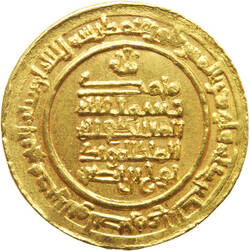No head, no animal, just writing – that's what strikes us as unusual about the look of this coin. The explanation is simple: visual representations of people and animals were banned under Islam for religious reasons.
The Persian Samanid dynasty reigned over large parts of Central Asia from the early ninth to the beginning of the 11th century. Their empire extended across large areas of present-day Uzbekistan, Turkmenistan, Tajikistan, Afghanistan and Iran. Rulers bore the title of Emir. Formally, they were subject to the Abbasid caliphs in Baghdad. The trade along the Silk Road soon brought them immense wealth and influence. They developed their capital Bukhara in present-day Uzbekistan into one of the most magnificent great cities of its day and a centre of Persian culture.
The gold coin on display here has a value of one dinar. It was issued by Emir al-Hamid Nuh ibn Nasr. The dinar weighs 5.12 grammes. That's well above the controlled standard weight of 4.25 grammes. Which confirms the theory that gold coins would have been added to the scales as required.
It's worth noting the script inside the central circle on the coin's obverse. It translates as:
There is no god but Allah, he has no partners.
Other identifiable elements are the name Nishapur, which was where the coin was struck; and the number 339, the year it was minted. The reverse of the gold piece features the names of the minting authority and of the Abbasid caliph in power in Baghdad.
Further Media
- Location & Dating
- Samanids, 339 AH (950-951)
- Material & Technique
- gold, embossed
- Dimenions
- Diameter: 24,0 mm; weight: 5,12 g
- Museum
- Münzkabinett
- Inventory number
- 2013/156
